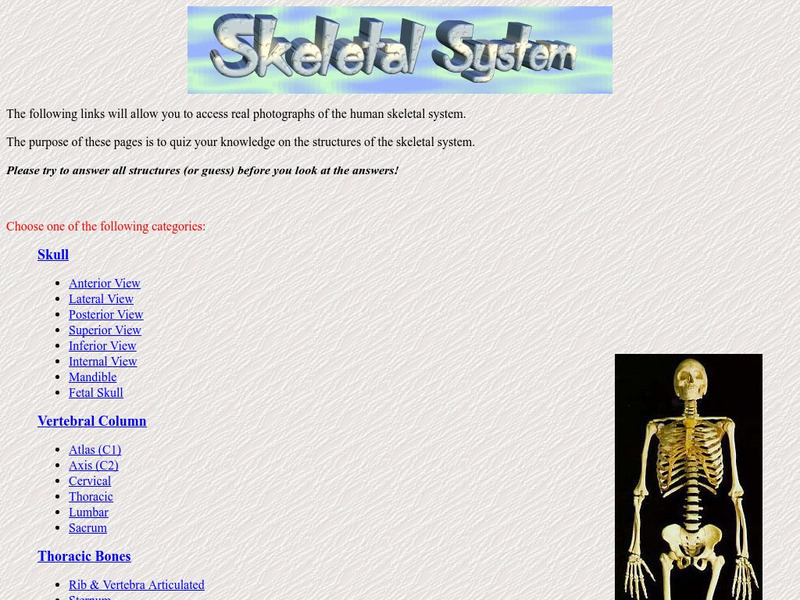Curated OER
Name the Bones of the Vertebrae
In this human vertebrae worksheet, students fill in 4 blanks with the names of the different parts of the spine. A diagram is included with parts already labeled for students to study.
California Academy of Science
Fish Forms
I've said it before, and I'll say it again, you can add art to any lesson! While little learners are discovering why fish have specific body parts such as, scales, fins, and gills, they start making three-dimensional fish forms. Children...
Curated OER
The Skeletal System
In this biology worksheet, 9th graders study the diagram of the dog shown and label the corresponding bones on the human skeleton. They explain some of the differences in location of the bones as compared to the dog.
Curated OER
The Nervous System
In this nervous system worksheet, 9th graders define each term listed and then label the figure shown pertaining to the nervous system. Then they name three types of neurons and describe the function of each type.
Curated OER
Sympathetic Division of the Autonomic Nervous System
In this anatomy worksheet, students label the autonomic nervous system. Students focus on the sympathetic division of the system. The locations along the spine are linked with pictures of the organs.
Curated OER
How 'bout them bones!
After a lesson on the human skeleton, hand out a worksheet that requires learners to identify the pelvis, rib cage, skill, spine, and thigh bones. They draw a line from the name of the bone to its location on the skeleton. Tip: Instead...
Curated OER
Everybody Needs a Little Sunshine
Three activities introduce upper elementary ecologists to photosynthesis and food webs. In the first, an experiment is set up to determine how plants respond to different types of light. In the second, they connect organism cards with...
Curated OER
Is It Slimy? Does It Have Fur? Is It Really a Bird?
Sixth graders identify the different types of vertebrate animals based upon their major characteristics, as they create collages in groups. Collages show pictures of vertebrate animals labeled with the appropriate structural...
Curated OER
The Human Skeleton
In this skeletal system worksheet, students label a diagram with the names of 12 bones in the human body. Students label the human skeleton in this online interactive worksheet by dragging the names of the bones to their appropriate boxes.
eSkeletons
Matching: Adult, Homo Sapiens
Looking for a basic skeleton-system-matching instructional activity? You've found it! Kids color in the skeleton bones with different colors before matching each bone to its correct name. The vocabulary isn't simple here;...
Curated OER
Show Some Backbone and Teach Invertebrates
Fifth graders identify two similarities and two differences between two phyla, assign fictitious invertebrate to its phylum and explain why it belongs in that grouping, and construct member of given phylum and explain why it should be...
Curated OER
A Helthy Diet
Students examine their eating habits and experience analyzing data and drawing conclusions. They construct models of the molecular backbone of saturated and unsaturated fats. In addition, they examine the labels of their food, record...
Curated OER
Minerals
Students compare the two main groups of minerals. In this nutritional lesson, students learn which foods contain the best source of minerals needed to maintain good health. They study the minerals that are required to be on the...
Curated OER
DNA and RNA
Tenth graders research the history and discovery of DNA. Using their text, they label a basic DNA structure and the composition of genes. They explain how RNA and DNA differ from one other and discuss the processes of transcription and...
Curated OER
Invertebrates
Middle schoolers examine invertebrates. In this animal classification instructional activity, students discuss invertebrates and bilateral symmetry. They discuss the importance of horse shoe crabs in medical science.
Curated OER
Vertebrates
Students identify and describe five main groups of the Phylum Chordata. They discover that the Phylum Chordata is the vertebrates. Students identify the main difference between invertebrates and vertebrates. They read passages about...
Curated OER
Amphibians
In this amphibian worksheet, students read about the frog life cycle to complete the Venn diagram. They also answer 16 fill in the blank questions about frogs.
Curated OER
Zoo Vet
Students come up with a list of all the animals that might be found in a zoo. They think of all the things that a zoo needs to do and provide for each animal. They discuss what the role of any zoo should be. They design a healthy zoo...
Curated OER
Regions and Habitats
Fourth graders identify the different habitats found in the seven regions of the United States. In this ecology activity, 4th graders write an essay about how humans affect the ecosystem and vice versa. They discuss how changes on one...
Pennsylvania State University
Pennsylvania State University: Skeletal System
In this resource, you will access photographs of the human skeletal system. A quiz is associated with each image which has numbered labels on the skeletal parts. Create a numbered list and write down the name for each part, then check...
Other
Southern California Institute: Pediatric Orthopedics
This resource is devoted to pediatric orthopedics and to the conditions of normal and abnormal bone development. Brief explanations about the anatomy of the spine, elbow, hip, hand, foot, knee, and shoulder are also provided, with...




















